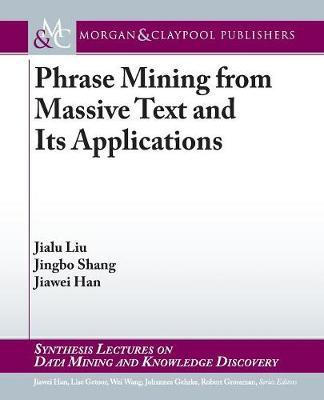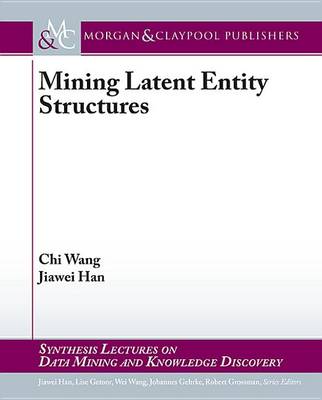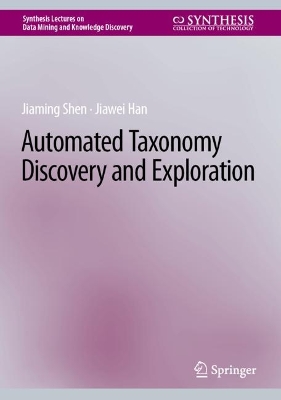Synthesis Lectures on Data Mining and Knowledge Discovery
7 total works
Phrase Mining from Massive Text and Its Applications
by Jialu Liu, Jingbo Shang, and Jiawei Han
In this book, we investigated one promising paradigm for representing unstructured text, that is, through automatically identifying high-quality phrases from innumerable documents. In contrast to a list of frequent n-grams without proper filtering, users are often more interested in results based on variable-length phrases with certain semantics such as scientific concepts, organizations, slogans, and so on. We propose new principles and powerful methodologies to achieve this goal, from the scenario where a user can provide meaningful guidance to a fully automated setting through distant learning. This book also introduces applications enabled by the mined phrases and points out some promising research directions.
Departing from many existing structure extraction methods that have heavy reliance on human annotated data for model training, our effort-light approach leverages human-curated facts stored in external knowledge bases as distant supervision and exploits rich data redundancy in large text corpora for context understanding. This effort-light mining approach leads to a series of new principles and powerful methodologies for structuring text corpora, including (1) entity recognition, typing and synonym discovery, (2) entity relation extraction, and (3) open-domain attribute-value mining and information extraction. This book introduces this new research frontier and points out some promising research directions.
Outlier Detection for Temporal Data
by Manish Gupta, Jing Gao, Charu Aggarwal, and Jiawei Han
Compared to general outlier detection, techniques for temporal outlier detection are very different. In this book, we will present an organized picture of both recent and past research in temporal outlier detection. We start with the basics and then ramp up the reader to the main ideas in state-of-the-art outlier detection techniques. We motivate the importance of temporal outlier detection and brief the challenges beyond usual outlier detection. Then, we list down a taxonomy of proposed techniques for temporal outlier detection. Such techniques broadly include statistical techniques (like AR models, Markov models, histograms, neural networks), distance- and density-based approaches, grouping-based approaches (clustering, community detection), network-based approaches, and spatio-temporal outlier detection approaches. We summarize by presenting a wide collection of applications where temporal outlier detection techniques have been applied to discover interesting outliers.
In this book, we investigate the principles and methodologies of mining heterogeneous information networks. Departing from many existing network models that view interconnected data as homogeneous graphs or networks, our semi-structured heterogeneous information network model leverages the rich semantics of typed nodes and links in a network and uncovers surprisingly rich knowledge from the network. This semi-structured heterogeneous network modeling leads to a series of new principles and powerful methodologies for mining interconnected data, including: (1) rank-based clustering and classification; (2) meta-path-based similarity search and mining; (3) relation strength-aware mining, and many other potential developments. This book introduces this new research frontier and points out some promising research directions.
This book presents data mining techniques that turn unstructured text data into multidimensional knowledge. We investigate two core questions. (1) How does one identify task-relevant text data with declarative queries in multiple dimensions? (2) How does one distill knowledge from text data in a multidimensional space? To address the above questions, we develop a text cube framework. First, we develop a cube construction module that organizes unstructured data into a cube structure, by discovering latent multidimensional and multi-granular structure from the unstructured text corpus and allocating documents into the structure. Second, we develop a cube exploitation module that models multiple dimensions in the cube space, thereby distilling from user-selected data multidimensional knowledge. Together, these two modules constitute an integrated pipeline: leveraging the cube structure, users can perform multidimensional, multigranular data selection with declarative queries; and with cube exploitation algorithms, users can extract multidimensional patterns from the selected data for decision making.
The proposed framework has two distinctive advantages when turning text data into multidimensional knowledge: flexibility and label-efficiency. First, it enables acquiring multidimensional knowledge flexibly, as the cube structure allows users to easily identify task-relevant data along multiple dimensions at varied granularities and further distill multidimensional knowledge. Second, the algorithms for cube construction and exploitation require little supervision; this makes the framework appealing for many applications where labeled data are expensive to obtain.






